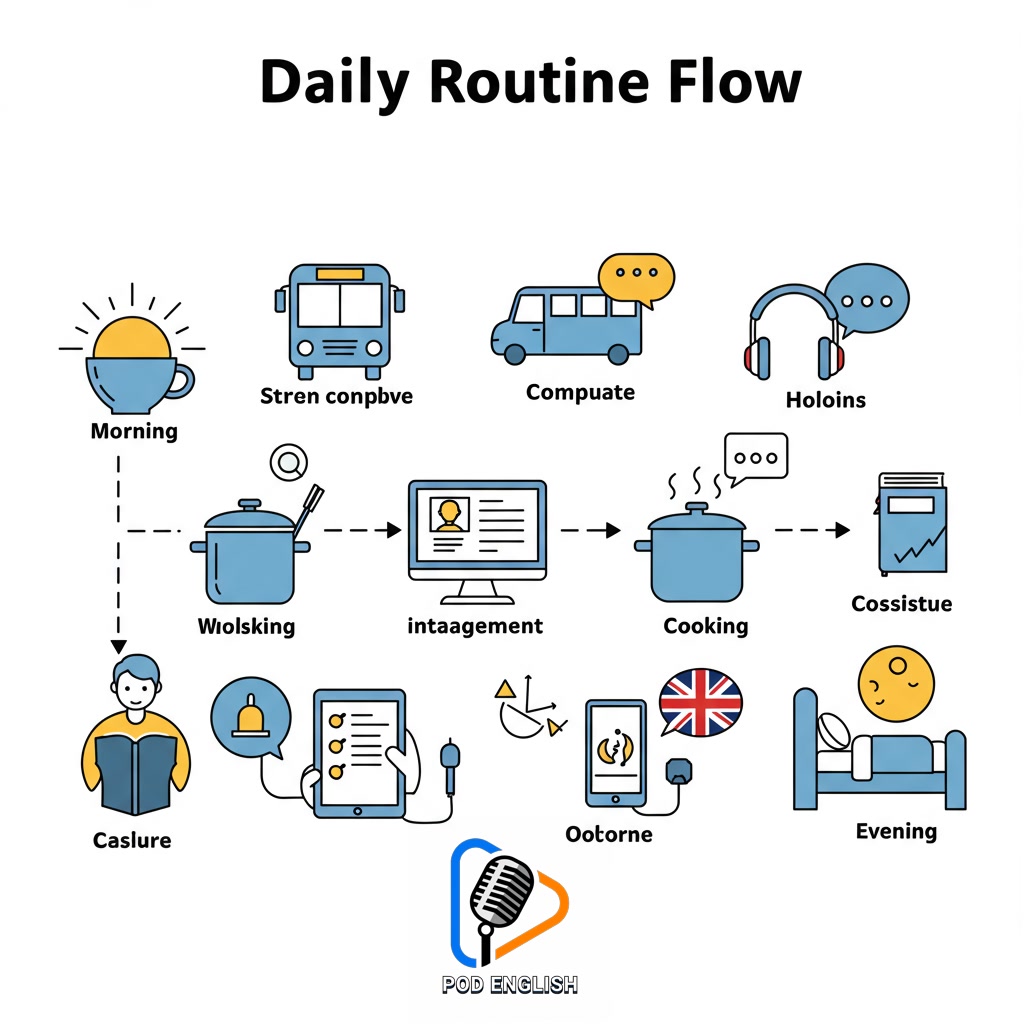Learn English
Seamlessly Integrate Studying English into Your Everyday Life: Practical Methods

This content explores effective strategies for blending English language acquisition into daily routines. It presents practical methods for making studying English a natural part of everyday activities. The focus is on actionable techniques to help learners practice English without feeling like it’s a separate, rigid task. By applying these approaches, individuals can consistently engage with the English language throughout their day.
Table of Contents
- Section 1: Introduction: Why Integrate English Study into Daily Life?
- Section 2: Identifying “Integration Points” in Your Daily Routine
- Section 3: Practical Ways to Integrate Listening and Speaking Practice
- Section 4: Practical Ways to Integrate Reading and Writing Practice
- Section 5: Leveraging Technology for Seamless Integration
- Section 6: Building Consistency and Maintaining Motivation
- Section 7: Conclusion: Making English Learning a Natural Habit
Section 1: Introduction: Why Integrate English Study into Daily Life?
Many English learners feel that studying is a separate, difficult task that requires dedicated time slots. This often leads to inconsistency and frustration. However, imagine making English a natural part of your daily life, like drinking coffee or commuting. Integrating English study means weaving language practice into activities you already do. Instead of viewing English as a chore, you can make it an enjoyable companion throughout your day. This approach offers constant exposure, reinforces learning without pressure, and makes progress feel less like a struggle and more like a continuous flow. Understanding *why* this integration is valuable is the first step towards building sustainable and effective learning habits.

Introduction: Why Integrate English Study into Daily Life?
Section 2: Identifying “Integration Points” in Your Daily Routine
Moving beyond the idea of English study as a separate chore begins with recognizing opportunities already present in your daily life. These aren’t large blocks of time, but rather small, existing moments – your “integration points” – where you can naturally weave in English practice. Think about your typical day from the moment you wake up until you go to sleep. What are the activities you do regularly without thinking much about them? Commuting, waiting in line, scrolling through social media, doing chores, cooking, taking a break, or even just getting ready in the morning. By consciously identifying these specific moments, you create a map of potential slots where a little bit of English can be added without disrupting your entire routine. The goal is to find these small pockets of time and make them work for your language learning.

Identifying
Section 3: Practical Ways to Integrate Listening and Speaking Practice
Building on the idea of utilizing small, existing moments, integrating listening and speaking practice becomes achievable. For listening, turn passive activities into active learning opportunities. Listen to English podcasts or audiobooks during your commute or while doing housework. Play English music and try to understand the lyrics, or tune into English news channels while getting ready in the morning. Speaking can be integrated by narrating your actions to yourself in English as you perform tasks, practicing the pronunciation of new words you encounter, or changing your phone’s voice assistant language to English and speaking commands. Even short, informal voice notes or brief calls with language exchange partners found online can provide valuable speaking practice without needing dedicated study blocks. The key is to weave these activities into your daily routine seamlessly.

Practical Ways to Integrate Listening and Speaking Practice
Section 4: Practical Ways to Integrate Reading and Writing Practice
Building on the idea of utilizing small, existing moments, integrating reading and writing practice becomes equally achievable. For reading, turn everyday interactions with text into learning opportunities. Read English labels on products, street signs, menu items, or short online articles and social media posts. Focus initially on understanding the general meaning rather than getting stuck on every word. For writing, practice by creating simple to-do lists, shopping lists, short diary entries, or brief comments on content you read online—all in English. These small, consistent acts of engaging with English text, both receptively and productively, reinforce vocabulary and grammar in a natural, low-pressure way, making them seamless additions to your daily routine.

Practical Ways to Integrate Reading and Writing Practice
Section 5: Leveraging Technology for Seamless Integration
Building upon the concept of utilizing existing moments, technology provides powerful tools for weaving English study effortlessly into your daily fabric. Instead of dedicated study blocks, leverage apps like Duolingo or Memrise during short commutes or waiting times. Transform passive activities such as cooking or cleaning by listening to English podcasts or audiobooks. Change the language settings on your phone or computer to English for constant exposure. Watch your favorite shows or movies with English subtitles, gradually transitioning to English audio only. Quick lookups of unfamiliar words using online dictionaries become seamless interruptions rather than study tasks. Online language exchange communities and forums offer casual speaking and writing practice integrated into your social media habits. By consciously choosing to interact with technology in English throughout the day, you create a pervasive learning environment that feels natural and integrated.

Leveraging Technology for Seamless Integration
Section 6: Building Consistency and Maintaining Motivation
Building consistency is the cornerstone of integrating English into your life without it feeling like a chore. It’s about establishing small, manageable habits that you can stick to daily, even for just a few minutes. Don’t aim for perfection; aim for presence. Engaging with English regularly, whether through a podcast during your commute, reading a short article during a break, or reviewing flashcards while waiting in line, reinforces learning over time far more effectively than infrequent, long study sessions. Maintaining motivation comes from connecting your English practice to your personal interests and noticing your own progress, however small. Celebrate these moments of improvement and remind yourself why you started this journey. By making English a consistent, low-pressure part of your routine, you create a sustainable path to fluency.

Building Consistency and Maintaining Motivation
Section 7: Conclusion: Making English Learning a Natural Habit
In conclusion, the journey to fluency isn’t about isolating English study into rigid blocks of time, but about weaving it into the fabric of your daily existence. By implementing the practical methods discussed – from leveraging commute time to integrating English into your hobbies – you transform learning from a chore into a natural habit. Consistency, even in small doses, builds momentum and makes engaging with English feel effortless and sustainable. As these practices become second nature, you’ll find yourself absorbing the language more effectively and consistently, making significant progress without the feeling of overwhelming effort. Embrace the process of making English a natural, enjoyable part of your life, and watch your confidence and skills flourish over time.

Conclusion: Making English Learning a Natural Habit













